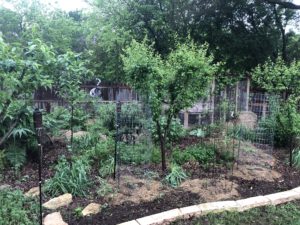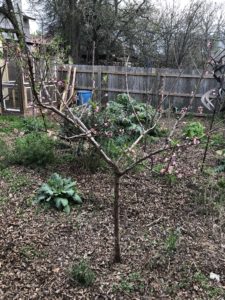Micro-Orcharding: Stacking Edible Diversity into Suburban and Urban Growing Spaces

Author’s backyard orchard in Spring 2020. Pictured L-R: Florida King Peach, Orient
Pear, Methley Plum, Saturn Peach, Santa Rosa Plum
“Micro-Orcharding” is a high-density planting technique that allows for maximum diversity in fruit and nut crops in smaller planting spaces. This method works well in the city and suburbs where space is at a premium, but is useful anywhere.
The concept is simple – you plant trees closer together than recommended. Then you keep the size of individual trees smaller year on year. This helps to maintain spacing and light whilst maximizing fruit diversity. Consistently reducing the size of a fruit tree will result in less fruit each year due to smaller canopy size. But the fruit that grows is more accessible and the increased numbers of trees can make up for smaller yields. Chances are, you can productively fit more trees into your suburban garden than you may have thought.
Benefits to Diverse Micro-Orcharding
There are many benefits to packing in a diversity of tree types into your garden space:
- Increased variety of fruit available in a small space
- Additional types of trees for cross-pollination purposes
- Extended blooming and harvest season using different cultivars and varieties
- Smaller trees in the garden can offer some shade protection to other heat susceptible plants
in late Summer - A wider diversity of plantings in the garden, which is generally beneficial for your whole
garden ecosystem
Choose the Tree for the Space
Choosing the trees that are right for your space will take some planning upfront. Make sure and plant trees that perform well locally and conform to your individual light and water conditions. See Fruit Varieties for Travis County for recommendations.
Make use of any micro-climates you have, as with citrus on a sunny south facing wall, heat-loving pomegranates on west facing exposures, or using deciduous species in north facing alleys between homes that only get light part of the year. Planting cultivars of the same species that fruit at slightly different periods can help stretch out the harvest, such as with different peach varieties like June Gold (June ripening) and La Feliciana (July ripening). For micro-orcharding, you can think of your trees more as large “fruit bushes”, rather than full size trees.
Dwarf varieties of individual fruit trees can be helpful as well, but are not necessary with regular pruning to keep the canopy open. Espalier techniques are another way to effectively use vertical spaces in smaller yards, also.
Maintenance Requirements for Micro-Orcharding
So the obvious next question is – how much maintenance will this take? It will take some effort to deal with the additional trees, though not as much as one would think. At planting, trees can be placed at about a 6’ – 8’ distance from one another. This is much less than the 20′ apart that many varieties normally recommend.
Early training of your fruit trees at planting is important in this method, to keep trunks squat and canopies lower. Generally, trees should be kept pruned down to below 10’ tall at all times, with a spread of about 6’ – 8’. A good rule is to keep the upper canopy of any fruit tree in your yard within your maximum reach by hand (about 6’ – 9’h for most people). There will be yearly maintenance thereafter – usually a hard prune in winter, and some years a smaller pruning during the growing season after harvest.
Learn the Growth Habit for Proper Pruning

Winter pruning of 5 year old June Gold peach
Different trees have different growth habits that determine the pruning and training methods that should be followed. Examples are open vase, central leader, and modified leader. Information on how to do this is available from the Aggie Horticulture Fruit and Nut Resources page.
If you’re wondering how this affects the health of the tree – many fruit trees respond well to frequent hard pruning, especially stone fruits, which do particularly well in our area. Driving through the Hill Country peach orchards, you might notice that no tree is allowed to grow to its maximum height, for the reasons listed above. Other tree types can be shaped over time to maximize production on a semi-permanent smaller frame.
In the more compact urban or suburban garden, smaller and more open trees have the added benefit of not blocking all the light coming into the garden, and can act as some much-needed late afternoon shade to more sensitive perennials and annuals. An additional benefit of all the regular pruning is lots of yearly mulch material is generated for the garden or compost bin – a small electric chipper is great to have around for this reason.
Choose the Right Variety
Major consideration should be given to what works well for your general area before planting a bunch of fruit trees in your yard. Luckily for us in Central Texas, there are lots of varieties that work very well and can be incorporated into this type of system. Peaches, plums, loquats, persimmons, pears, asian pears, pomegranates, and even cold hardy citrus (for the brave after the recent deep freeze) will work nicely in the micro-orchard.
Backyard orchard culture fits very well into an overall plan for stacking density and variety into your landscape, and can expand the playing field for gardeners in the city that want more edible varieties to choose from.
Additional Resources
Backyard Fruit and Nut Production for Austin Area
Fruit Varieties for Travis County
Aggie Horticulture Fruit and Nut Resources
About Reed Burnam

Originally from Houston, Reed has been in Austin for 20 years, with short stints living in Southern California and Northern India. He holds BAs in History and Philosophy, and an MA in South Asian Cultures and Languages, all from UT Austin. He’s been designing, installing, and maintaining professional landscape plans for clients around Austin since 2013, working with Austin-based Fertile Ground Organic Gardens. Hands in the soil most of his life, he has a love and appreciation for all forms of life, even poison ivy, yellowjackets, and fire ants. Reed became a Travis County Master Gardener in 2019 and has been thoroughly enjoying the volunteerism, connections, and further learning the program has offered.
Reed is an avid enthusiast of regenerative gardening, urban orchards, rainwater harvesting, forest gardening, composting, backyard poultry, and edible landscaping. He has taught permaculture design both locally in Austin and internationally since 2013, and teaches yearly PDCs with friends in India when there isn’t a global pandemic happening. Reed currently resides in South Austin, where he lives with his wife, more fruit trees than he cares to count, and a small herd of domestic animals.

